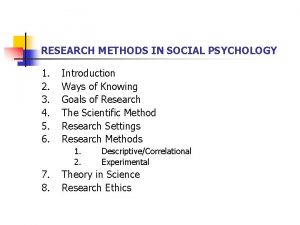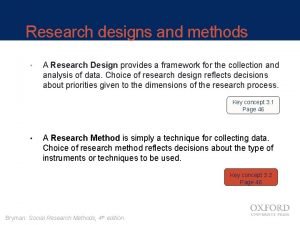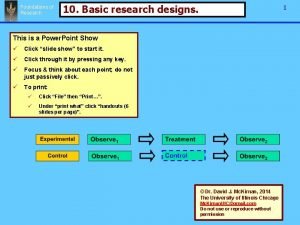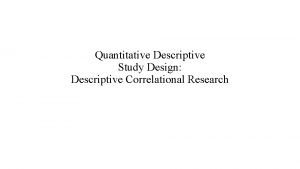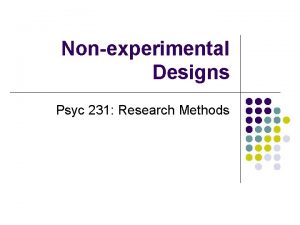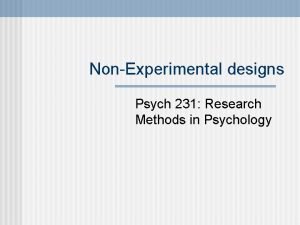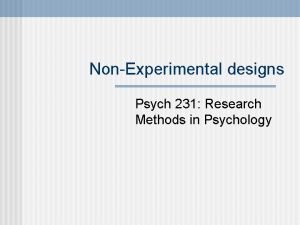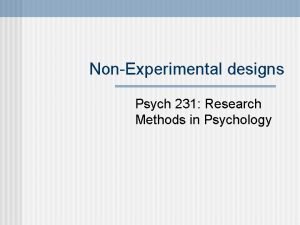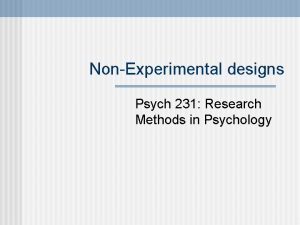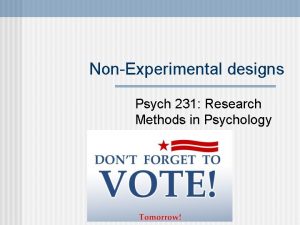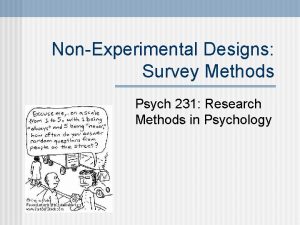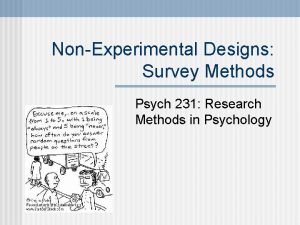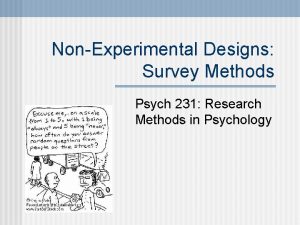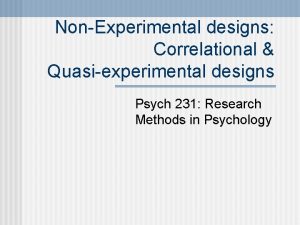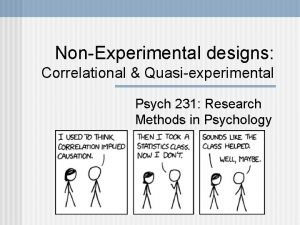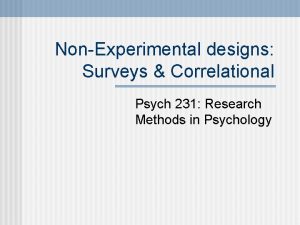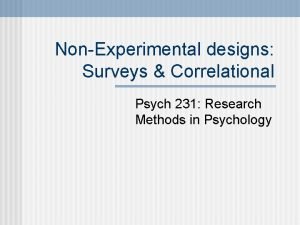NonExperimental designs Psych 231 Research Methods in Psychology































- Slides: 31

Non-Experimental designs Psych 231: Research Methods in Psychology

n Journal Summary 2 due this week Announcements

n Stage 6) Designing the survey instrument n Question construction: How the questions are written is very important • Clearly identify the research objectives • Do your questions really target those research objectives? • Take care wording of the questions • Keep it simple, don’t ask two things at once, avoid loaded or biased questions, etc. • How should questions be answered? Stages of survey research cont.

n Question types n Open-ended (fill in the blank, short answer) • Can get a lot of information, but • Coding is time intensive and potentially ambiguous n Close-ended (pick best answer, pick all that apply) • Easier to code • Response alternatives are the same for everyone n Rating scales • Used for “how much” judgments • e. g. , Likert scale – measures attitudes, agree/disagree • Take care with your labels • Range of scores, anchors Survey Questions

n Stage 7) Pre-testing the survey instrument n n Stage 8) Selecting and training interviewers n n n Fix what doesn’t seem to be working For telephone and in-person surveys Need to avoid interviewer bias Stage 9) Implementing the survey Stage 10) Coding and entering the data Stage 11) Analyzing the data and preparing a final report Stages of survey research cont.

n What are quasi-experiments? n Almost “true” experiments, but with an inherent confounding variable • Design includes a quasi-independent variable • Examples • An event occurs that the experimenter doesn’t manipulate • Interested in subject variables • Time is used as a variable Quasi-experiments

n What are quasi-experiments? n n Almost “true” experiments, but with an inherent confounding variable Advantages n n Allows applied research when experiments not possible Threats to internal validity can (sometimes) be assessed Quasi-experiments

n What are quasi-experiments? n Almost “true” experiments, but with an inherent confounding variable § Disadvantages § Threats to internal validity may exist (which can not be addressed) § Be careful when making causal claims § Statistical analysis can be difficult § Most statistical analyses assume randomness Quasi-experiments

n What are quasi-experiments? n Almost “true” experiments, but with an inherent confounding variable n Common types n Nonequivalent control group designs n Program evaluation n Interrupted time series designs Quasi-experiments

n Nonequivalent control group designs n With pretest and posttest (most common) Non-Random Assignment Dependent Variable Measure Independent Variable Experimental group Dependent Variable Measure participants Measure Control group Measure – But remember that the results may be compromised because of the nonequivalent control group Quasi-experiments

Program evaluation n – Research on programs that is implemented to achieve some positive effect on a group of individuals. – – e. g. , does abstinence from sex program work in schools Steps in program evaluation: 1. 2. 3. 4. 5. Needs assessment - is there a problem? Program theory assessment - does program address the needs? Process evaluation - does it reach the target population? Is it being run correctly? Outcome evaluation - are the intended outcomes being realized? Efficiency assessment- was it “worth” it? The the benefits worth the costs? Quasi-experiments

n Time series designs n Basic method: Observe a single group multiple times prior to and after a treatment Obs Obs Obs § The pretest observations allow the researcher to look for pre-existing trends § The posttest observations allow the researcher to look for changes in the trends § Is it a temporary change, does it last, etc. ? Quasi-experiments

n Time series designs n A variation of basic time series design • Addition of a nonequivalent no-treatment control group time series Obs Obs Obs treatment Obs Obs Obs Quasi-experiments

n Used to study changes in behavior that occur as a function of age changes n n Age typically serves as a quasi-independent variable Three major types n n n Cross-sectional Longitudinal Cohort-sequential Developmental designs

n Cross-sectional design n Groups are pre-defined on the basis of a preexisting variable • Study groups of individuals of different ages at the same time • Use age to assign participants to group • Age is subject variable treated as a between-subjects variable Developmental designs

n Cross-sectional design n Advantages: • • Can gather data about different groups (i. e. , ages) at the same time Participants are not required to commit for an extended period of time Developmental designs

n Cross-sectional design n Disavantages: • Individuals are not followed over time • Cohort (or generation) effect: individuals of different ages may be inherently different due to factors in the environment • • Example: are 5 year old different from 13 year olds just because of age, or can factors present in their environment contribute to the differences? Cannot infer causality due to lack of control Developmental designs

n Longitudinal design n Follow the same individual or group over time • Age is treated as a within-subjects variable • • • Rather than comparing groups, the same individuals are compared to themselves at different times Repeated measurements over extended period of time Changes in dependent variable likely to reflect changes due to aging process • Changes in performance are compared on an individual basis and overall Developmental designs

n Longitudinal design n Advantages: • Can see developmental changes clearly • Avoid some cohort effects (participants are all from same generation, so changes are more likely to be due to aging) • Can measure differences within individuals Developmental designs

n Longitudinal design n Disadvantages • Can be very time-consuming • Can have cross-generational effects: • Conclusions based on members of one generation may not apply to other generations • Numerous threats to internal validity: • Attrition/mortality • History • Practice effects • Improved performance over multiple tests may be due to practice taking the test • Cannot determine causality Developmental designs

n Cohort-sequential design n Measure groups of participants as they age • Example: measure a group of 5 year olds, then the same group 5 years later, as well as another group of 5 year olds n Age is both between and within subjects variable • Combines elements of cross-sectional and longitudinal designs • Addresses some of the concerns raised by other designs • For example, allows to evaluate the contribution of generation effects Developmental designs

n Cohort-sequential design n Advantages: • Can measure generation effect • Less time-consuming than longitudinal n Disadvantages: • Still time-consuming • Still cannot make causal claims Developmental designs

n What are they? n n Historically, these were the typical kind of design used until 1920’s when there was a shift to using larger sample sizes Even today, in some sub-areas, using small N designs is common place • (e. g. , psychophysics, clinical settings, expertise, etc. ) Small N designs

n n One or a few participants Data are not analyzed statistically; rather rely on visual interpretation of the data Observations begin in the absence of treatment (BASELINE) Then treatment is implemented and changes in frequency, magnitude, or intensity of behavior are recorded Small N designs

n Baseline experiments – the basic idea is to show: 1. when the IV occurs, you get the effect 2. when the IV doesn’t occur, you don’t get the effect (reversibility) § § Before introducing treatment (IV), baseline needs to be stable Measure level and trend Small N designs

n Level – how frequent (how intense) is behavior? n n Are all the data points high or low? Trend – does behavior seem to increase (or decrease) n Are data points “flat” or on a slope? Small N designs

n ABA design (baseline, treatment, baseline) – The reversibility is necessary, otherwise something else may have caused the effect other than the IV (e. g. , history, maturation, etc. ) ABA design

n Advantages n n n Focus on individual performance, not fooled by group averaging effects Focus is on big effects (small effects typically can’t be seen without using large groups) Avoid some ethical problems – e. g. , with nontreatments Allows to look at unusual (and rare) types of subjects (e. g. , case studies of amnesics, experts vs. novices) Often used to supplement large N studies, with more observations on fewer subjects Small N designs

n Disadvantages n n Effects may be small relative to variability of situation so NEED more observation Some effects are by definition between subjects • Treatment leads to a lasting change, so you don’t get reversals n Difficult to determine how generalizable the effects are Small N designs

n n Some researchers have argued that Small N designs are the best way to go. The goal of psychology is to describe behavior of an individual Looking at data collapsed over groups “looks” in the wrong place Need to look at the data at the level of the individual Small N designs

n Statistics (Chapter 14) Next time
 Experimental vs nonexperimental research
Experimental vs nonexperimental research Experimental vs non experimental
Experimental vs non experimental Classical conditioning
Classical conditioning Social loafing ap psychology definition
Social loafing ap psychology definition Methods of social psychology
Methods of social psychology Research methods in developmental psychology
Research methods in developmental psychology Research methods in abnormal psychology
Research methods in abnormal psychology Ocr psychology research methods
Ocr psychology research methods Psychology research methods worksheet answers
Psychology research methods worksheet answers Chapter 10 qualitative research designs
Chapter 10 qualitative research designs Categories of research design
Categories of research design Basic research designs
Basic research designs Qualitative research designs chapter 10
Qualitative research designs chapter 10 Types of qualitative designs
Types of qualitative designs Types of action research
Types of action research Empirical approach
Empirical approach Disadvantage of quasi experiment
Disadvantage of quasi experiment Descriptive-correlational design
Descriptive-correlational design What is a research design
What is a research design Exploratory vs descriptive vs causal research
Exploratory vs descriptive vs causal research Casual research example
Casual research example Advantages of conclusive research design
Advantages of conclusive research design Univariate descriptive design
Univariate descriptive design What are the characteristics of a qualitative research
What are the characteristics of a qualitative research Types of exploratory research
Types of exploratory research Classification of research design
Classification of research design Conclusive research design
Conclusive research design Quasi-experimental research designs
Quasi-experimental research designs Quasi-experimental research designs
Quasi-experimental research designs A-wax pattern recognition
A-wax pattern recognition Acf 231
Acf 231 Article 231 of the treaty of versailles
Article 231 of the treaty of versailles




